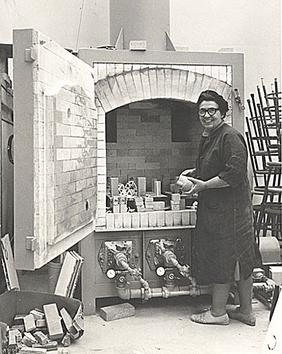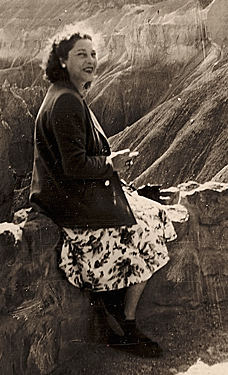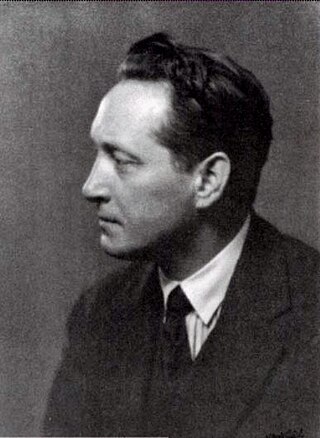This article needs additional citations for verification .(July 2023) |
Gladys Aller (July 13, 1915 - March 5, 1970) was an American painter.
This article needs additional citations for verification .(July 2023) |
Gladys Aller (July 13, 1915 - March 5, 1970) was an American painter.
Gladys Aller was born in Massachusetts. Until applying for a passport in her forties, she thought she was born on July 14. Her father, Simeon Aller, being superstitious about Friday the 13th, had always told her she was born the day after. Her family was involved in music and the movie industry. Her father was a Jewish Russian emigre who moved with his brother, Joseph Aller, to Hollywood in 1920 to work in the film industry. Her uncle Joseph ran the darkroom for D. W. Griffith while her father sold raw film to the studios for Dupont. Her uncle Modest Altschuler was the conductor and founder of the Russian Symphony Orchestra while her uncle Gregory (Grisha) Aller and her cousin Eleanor Aller were both cellists and her cousin was pianist Victor Aller. Her cousin Boris Leven was an art director.
She was the youngest member admitted to the California Watercolor Society [1] at the age of 14. At 15 she left high school to attend the Otis Art Institute (now called the Otis College of Art and Design). She also studied in Los Angeles at Chouinard Art Institute. In 1933 she went to New York City to study at The Art Students League of New York with George Grosz, Richard Lahey, and John Sloan.
Her watercolor "Portrait of Helen" was purchased by the New York Metropolitan Museum in 1937. [2] In the Metropolitan Museum of Art Bulletin 35.11 in 1940, Harry B. Wehle wrote, "The West Coast has in recent years produced a particularly promising crop of water colorists, including Millard Sheets, Dong Kingman, George Post, Alexander Nepote, Milford Zornes and Gladys Aller." [3]
Other exhibits include the California Water Color Society, 1930-46 (prizes); Painters & Sculptors of LA, 1937–38; Los Angeles County Museum of Art (LACMA), 1941–43; Pennsylvania Academy of Fine Arts PAFA, 1937–40; Zeitlin Gallery (LA), 1938 (solo); All-Calif. Exhibition, 1939; Museum of Fine Arts, Boston, Brooklyn Museum, the Legion of Honor at San Francisco, San Diego Gallery of Fine Arts, and Riverside Museum in New York City.
As an example of the art scene in Los Angeles in the 1930s, in February 1937, the Los Angeles unit of the American Artists' Congress held a Surrealist Valentine's Ball in Hollywood. Los Angeles artists gathered in elaborate costumes. Fletcher Martin, Edward Biberman, Eula Long, Brooke Waring, Tom Craig, Yvonne Siegel, Elaine Fullerson, and Charles Teske participated. Costumes were judged by Jean Muir, George Antheil, Paul T. Franco and Stella Adler while Eddie Barefield's swing band played.
On July 14, 1941, she married orthodontist Dr. Eugene "Jimmy" Farber, DDS, and moved with him to Los Angeles. After the Japanese attacked Pearl Harbor in December of that same year, her husband joined the US Air Force as a dentist. She accompanied him to his postings at Hamilton Air Force Base in Northern California, and at Tonopah Army Air Field (now known as Tonopah Air Force Base in Nevada. There she taught painting to the officers' wives and was fascinated by the landscape there, painting her "Two Women of Tonopah." She also painted her "Tonopah Laundry" oil focusing on the migrant women laborers.
After the war, they returned to Los Angeles, where her husband started a practice in Beverly Hills, and they raised two children. A number of her cubist style portraits of women were painted after the war, such as "Lady With Hat."
In the 1960s Gladys Aller, now known as Gladys Farber, became politically active, starting with "SOS - Stamp Out Smog" which led to the Clean Air Act. She was one of the original members of Women Strike for Peace working for nuclear disarmament and the Test Ban Treaty. She helped organize, and traveled on, a trip to the Soviet Union in the midst of the Cold War which they called "Women's Peace Plane to Moscow" in 1963. [4] She subsequently became active in the anti-Vietnam War movement.[ citation needed ]
Artistically, in the 1950s and 1960s, her work moved away from figurative watercolors and oils and towards abstract expressionism from the earlier influences of the Ashcan School, the Southern California watercolor school, Diego Rivera and the Mexican Mural Movement, and German Expressionism.[ citation needed ] She worked in the studio of LA artist Sueo Serisawa. A close group of women painters gathered in that studio in the 1960s, often combining art with politics. Mary Clarke, Lucy Adelman (who was later one of the founders of the Womanspace Gallery and subsequently the ArtSpace Gallery), and Wallace Albertson were some of the other painters in the group.
Southern California Artists (Nancy Moure); [6] California Arts and Architecture list, 1932; Who's Who in American Art 1938-62.

Elaine Marie Catherine de Kooning was an Abstract Expressionist and Figurative Expressionist painter in the post-World War II era. She wrote extensively on the art of the period and was an editorial associate for Art News magazine.

Marion Kavanaugh Wachtel was an American plein air painter in watercolors and oils. She lived and worked with her artist husband Elmer Wachtel in the Arroyo Seco near Pasadena, California, in the early 20th century.

Maurice Braun (1877–1941) was an American artist who became known for his Impressionist landscapes of southern California. He was born in Hungary on October 1, 1877; however, by the age of four, young Maurice and the Braun family had migrated to United States, and settled in New York City. His professional studies took him to the National Academy of Design, where he studied the French tradition under Francis C. Jones, George W. Maynard and Edgar M. Ward.

Franz Albert Bischoff was an American artist known primarily for his China painting, floral paintings and California landscapes. He was born in Steinschönau, Austria. He immigrated to the United States as a teenager where he became a naturalized citizen. While in Europe, his early training was focused upon applied design, watercolor and ceramic decorations.

Hans Gustav Burkhardt was a Swiss-American abstract expressionist artist.

Theodore Nikolai Lukits was a Romanian American portrait and landscape painter. His initial fame came from his portraits of glamorous actresses of the silent film era, but since his death, his Asian-inspired works, figures drawn from Hispanic California and pastel landscapes have received greater attention.

Colin Campbell Cooper, Jr. was an American impressionist painter of architectural paintings, especially of skyscrapers in New York City, Philadelphia, and Chicago. An avid traveler, he was also known for his paintings of European and Asian landmarks, as well as natural landscapes, portraits, florals, and interiors. In addition to being a painter, he was also a teacher and writer. His first wife, Emma Lampert Cooper, was also a highly regarded painter.

Thelma Beatrice Johnson Streat (1912–1959) was an African-American artist, dancer, and educator. She gained prominence in the 1940s for her art, performance and work to foster intercultural understanding and appreciation.
Gladys M. Nilsson is an American artist, and one of the original Hairy Who Chicago Imagists, a group of representational artists active during the 1960s and 1970s. She is married to fellow-artist and Hairy Who member Jim Nutt.

Alexandra Bradshaw, also known as Alexandra Bradshaw Hoag, was a Canadian-American watercolor artist and art professor. She studied art in the United States and Paris and became an instructor and head of the Fine Arts department at Fresno State College in California. Her works were exhibited in group and solo exhibitions throughout California and the United States from the 1930s through the 1960s. She married late in life to Clarence Hoag, the founder of Hoag Press in Boston. Their residence in Wakefield, Massachusetts, was Castle Clare and Bradshaw kept her house in South Laguna, California.

Laura Andreson was an American ceramic artist and educator at University of California Los Angeles.

Margaret Tomkins (1916–2002) was an American Surrealist / Abstract Expressionist painter. Though born, raised, and educated in Southern California, she spent most of her life in the Pacific Northwest, where she was well known both for her art and her energetic, outspoken art activism. Her Surrealist works of the 1940s earned considerable national attention, and as her work evolved in the 1950s and 1960s, she came to be known as a pioneer in Abstract Expressionism. Tomkins was the driving force behind the first artist-owned gallery in Seattle, Washington. Though friends with many of the artists of the Northwest School, she denied any artistic connection to these "mystic" painters, at times deriding their claims of quasi-magical inspiration from nature as "silly". She was similarly dismissive of any categorization based on her gender.

Elsie Lower Pomeroy (1882-1971) was an artist most closely associated with the American Scene Painting movement and specifically California Regionalism or California Scene Painting. She was also one of a small group of botanical illustrators who worked for the United States Department of Agriculture (USDA) in the early 20th century.

Z. Vanessa Helder was an American watercolor painter who gained national attention in the 1930s and 40s, mainly for her paintings of scenes in Eastern Washington. She painted with a bold, Precisionist style not commonly associated with watercolor, rendering landscapes, industrial scenes, and houses with a Magic Realist touch that gave them a forlorn, isolated quality, somewhat in the manner of Charles Sheeler and Edward Hopper. She spent most of her career in the Pacific Northwest, but was popular in New York art galleries, was a member of the National Association of Women Painters and Sculptors, and, in 1943, was included in a major exhibit at the Museum of Modern Art.

Helen Katharine Forbes was a Californian artist and arts educator specializing in etching, murals and painting. She is best known for western landscapes, portrait paintings, and her murals with the Treasury Section of Fine Arts and Work Progress Administration (WPA). Forbes was skilled in painting in oil, watercolor, and egg tempera. She painted landscapes of Mexico, Mono Lake and the Sierras in the 1920s, desert scenes of Death Valley in the 1930s, and portraits and still-lifes.
Donna N. Schuster was an American easel painter, who created work in the style of modern impressionism using the medium of oil and watercolor. She focused her work in Wisconsin then later moved to Los Angeles, California where she died in 1953.
Nell Brooker Mayhew was an American painter, etcher and art instructor.

Edith Bry (1898–1991) was an American painter, printmaker, and glass artist. During her long career she combined technical skill with an impulse to innovate. Critics noted her versatility, pointing to skill in handling oil painting, lithography, etching, drawing, watercolor, and wood carving. Her style ranged from realist to abstract and from what one critic called a "discipline of an inner reticence" to a "more dynamic emotional expressionism." Her early-career still lifes drew praise and a figure-group called "Exiles" received much attention following its acquisition by the Metropolitan Museum of Art. Her mid-career work was more expressive and abstract as she tried, as she put it, to rid herself "from the tyranny of nature." At the end of her career she was particularly known for semi-abstract work in glass and enamel, mainly of religious subjects.

Susan Landauer (1958–2020) was an American art historian, author, and curator of modern and contemporary art based in California. She worked for three decades, both independently and as chief curator of the San Jose Museum of Art (SJMA) and co-founder of the San Francisco Center for the Book. Landauer was known for championing movements and idioms of California art, overlooked artists of the past, women artists, and artists of color. She organized exhibitions that gained national attention; among the best known are: "The San Francisco School of Abstract Expressionism", "Visual Politics: The Art of Engagement", and retrospectives of Elmer Bischoff, Roy De Forest, and Franklin Williams. Her work was recognized with awards and grants from the International Association of Art Critics, National Endowment for the Arts and Henry Luce Foundation, among others. Critics, including Roberta Smith and Christopher Knight, praised her scholarship on San Francisco Abstract Expressionism, De Forest, Richard Diebenkorn, and Bernice Bing, among others, as pioneering. In 2021, Art in America editor and curator Michael Duncan said that "no other scholar has contributed as much to the study of California art." Landauer died of lung cancer at age 62 in Oakland on December 19, 2020.

John O'Shea was a California impressionist painter known for landscape, marine, figure, and portrait painting. He was one of the major artists in Carmel-by-the-Sea, California between 1917-1945. He was a resident of Carmel for 36 years.